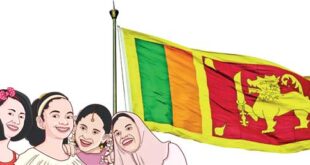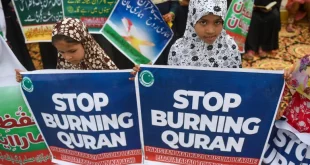Of late the religious minorities in India have been subjected to discrimination, harassment and atrocities of all kinds. Not many such incidents are brought to the notice of the law-enforcing authorities, for; those at the helm of affairs by and large belong to majority-community, otherwise known as Hindu community. Even those incidents that are highlighted are either manipulated or hushed up somehow. The incidents that are marked by anti-minority attitude of the government employees are being set aside for want of follow-up from the minorities. At times, such incidents are diluted and portrayed as those that stem from the individual rivalry on account of trespass and civil tort. Attempts are also made to show them as such incidents which are not smacked of any communal bias. But then, there are innumerable incidents, be they apparent or latent, speak volumes to vindicate the point that it is communal angle that is predominant in all of them. Again, it is minorities who are at the receiving end in most of the cases. Gujarat killings are still fresh in our memory.
Suffice it to cite a case of a naked atrocity to secure forcible migration of a 70-year old minority community widow, Mrs Ahmadi Khan in the village of Jassipur of Mayurbhanj district in the state of Orissa on January 28, 2009. More than the agony that the old lady suffered due to the atrocity of Anil Modak and others on another occasion (May11, 2009) also, the criminal role of local VHP/Bajrangdal activists with the connivance of local police that caused her depression added injury to the insult. Despite her request to the Mayurbhanj SP, the FIR was not filed till date. In contrast, a false case was foisted against her, courtesy another police official in the district. There were attempts to approach the National Human Rights Commission, the Minorities Commission, besides the PIL in the Cuttack Court. But no significant remedy is available to the aggrieved party, the old lady. It seems that the Orissa High Court had directed the CB-CID last week to conduct enquiry and submit status report within a week, but in vain. There are several such incidents that are marked by communal colour seemed to be happening in various parts of the country.. The society is so polarised that such cases are being viewed as communal ones, and thus justified if that victims does not belong to them. Sensitivity to such heinous crimes is lost and humanity has become a casualty.
While it is unfair to brand all Hindus as communal, it is also unfair to paint all minorities, be they Muslims, Christians, Sikhs, jains etc., as fundamentalist. In other words, it is pointless to generalise all the religious people as communal as there are only a handful of such people in any religion who, at times, become narrow-minded and chauvinistic. Their overt and covert actions of spontaneous nature might provoke reactions from the rival groups that tend to jeopardise the peace and tranquillity in the society. Sometimes such actions lead to the rise of communal riots, whereas at some other times, they might lead to the vertical division of the society on the basis of religion, as was the case with the partition of India in 1947!
Besides, there are also times when mere doubts and apprehensions about the minority communities are raised and propagated in the public and private fora. Although such deliberate acts do not lead to any violent incidents these would certainly create mental agony and distress among the minorities. As a result, minorities feel humiliated and harassed even when they are not at fault. Meanwhile, the religious fundamentalists and communalists take this opportunity to their advantage and attribute malintentions and treachery to the minorities. In fact, there are occasions (International Sporting events etc.,) when the minorities are treated as traitors of the country and thus, abused as antinationalistic once for all! This sort of sectarian attitude in the majority community towards the minorities would keep them insecure. Thus, their apprehensions about lack of protection of right, liberty and property are understandable. It is time the governments implement the reports of Rajendra Sachar Committee that concern the overall development of minorities in the country.
Thanks to the prevailing socio-economic conditions that are responsible for marginalising them would compel some such aggrieved persons to behave in an abnormal manner. In any democratic society it is numbers that matter. But it does not mean that minorities and their views are to be neglected nor undermined during the course of decision-making. Majority always does not represent common interest, leave alone rational interests. At times, it so happens that even minority would also represent the interest of majority, if not interests of all. Viewed in that perspective, one should be careful about the views of both majority and minority, and due recognition is to be paid to both the views invariably.
As a matter of fact, majority has been viewed as ‘’mobocracy’ from the ancient times onwards. Sometimes, its practice would lead to development of perverted form of governance whereby reason and rationality become casualties. Incidentally, ancient philosophers like Socrates and Plato suffered during the regimes of democrats, for being truthful and straightforward. Even Lord Jesus Christ and Prophet Muhammad also faced the same wrath of mobs of their times. There were several such examples that can be traced in the history. Thus, democracy should not be treated as merely head-counting and thereby giving the reason, rationality and logic a go-bye!
Meanwhile, the concept of minorities has been understood in many ways. It is not religion alone that could be the basis for categorizing people in terms of majority and minorities. Language, culture, geography, gender, colour, caste, sub-caste and other aspects could also to be taken as factors for categorization. For instance, in the case of Hinduism, all castes and sub-castes are further categorized as distinct communities that constitute different sizes of population. Given this sort of categorization, Hindus per se do not become the majority-community. It is a community of communities of different castes and sub-castes, whose interests clash each other and one another. In the recent past, Hindus are found to be engaged in acrimonious battles for sharing power, political and otherwise. Failed to inculcate the noble feelings of Dr.BRAmbedkar, father of Indian constitution, the upper caste Hindus are not treating the so-called lower castes as brothers and sisters. The social evil of untouchability has been practised though it is prohibited in the Constitution, the sacred document of India.
The marginalised communities like Dalits, Adivasis, OBCs and women have been deprived of their constitutional rights on end. Obviously, the majority Vs minority controversy has taken a different turn with the spread of Ambedkar philosophy, and more so with popularisation of the concept of Bahujan Samaj of Manyasri kanshiramji! While the majority Hindus are polarised in terms of minority-Upper castes that constitute Brahmins, Kshatriyas and Vyshyas on the one hand, the majority-Lower castes that constitute the Shudras and Atishudras, on the other hand. Since the majority-Lower castes are found oppressed socially and otherwise at the hands of Upper castes, they wish to break the chains of Hinduism only to join the religious minorities of Islam, Christianity, Sikhism, Buddhism and Jainism as a larger entity. Since the idea is based on apprehensions of the marginalised communities, its implementation would certainly alter the social composition of the majority and minority notions. Ultimately, this larger entity would make them majority for political purpose that would ensure political power over a period of time. That alone would assure minimum rights for the minorities who are otherwise feel suffocating due to communal perpetuation.
The author is a Research Associate, Dept. Of Political Science, Osmania University, Hyderabad,
Countercurrents.org
 Sri lanka Muslims Web Portal Diversity and Inclusiveness
Sri lanka Muslims Web Portal Diversity and Inclusiveness




I believe that what this article is saying is of crucial importance for understanding what is going on in the world today. It is generally acknowledged that identity is the most important factor in contemporary politics. But “identity” is understood too broadly. For instance “ethnic” is a valid identity term.But to get the full picture of the ethnic we must take into account also the sub-ethnic such as caste.